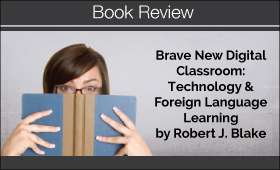Book Review: Brave New Digital Classroom: Technology and Foreign Language Learning by Robert J. Blake
 By Adrienne Gonzales, PhD, Foreign Language Pedagogy & Technology Specialist at University of Denver, CO.
By Adrienne Gonzales, PhD, Foreign Language Pedagogy & Technology Specialist at University of Denver, CO.
DOI: https://www.doi.org/10.69732/BXZO7645
Brave New Digital Classroom: Technology and Foreign Language Learning by Robert J. Blake explores the potential pedagogical benefits of technology and how technology assisted activities can and should fit into the foreign language (FL) curriculum. The book, directed at Chairs, administrators, and both experienced and inexperienced teachers, serves not as a how-to manual, but rather as a discussion intended to spark the imaginations of already technologically experienced teachers and to motivate technologically inexperienced teachers to acquire the skills needed to incorporate technology into their classrooms.
Blake separates the book into six chapters: SLA, Language Teaching, and Technology: An Overview, which focuses on providing an overview of SLA theories, particularly those involving the concept of input; Web Pages in Service of L2 Learning, which discusses Internet history, concepts, resources, and advice; CALL and Its Evaluation, which reviews a history of CALL and its place in the profession; Computer Mediated Communication, which explores the opportunities afforded by CMC, including a description of the Cultura project; Distance Learning for Languages: Does It Measure Up?, which discusses online and hybrid courses and describes a study of oral proficiency in Spanish without Walls courses; and Putting it All Together, a summary of the main components and arguments of the book. Each chapter closes with discussion questions and activities for the reader. These exercises prompt the reader to further investigate the themes of the chapter and apply these concepts to real-life scenarios and are appropriate and valuable for teacher preparation programs, graduate level seminars, or peer teacher reading groups.
Throughout the book, Blake highlights and refutes four common myths about technology and SLA that hinder its use in the FL curriculum: technology is monolithic, technology constitutes a methodology, today’s technology is all we need to know, and technology will replace teachers. Ultimately, Brave New Digital Classroom advocates for a transformation of FL curricula, emphasizing pedagogical threads that should guide technology integration in the classroom: multiple points of entry; emphasis on the SLA theory and not the tool; student-centered classrooms; interactivity, agency, and students as (co-)producers of technologically enhanced materials; and the development of intercultural communicative competence. Blake argues that ultimately this process begins with a culture shift, asserting that “If our best and most experienced language teachers are afraid to harness the power of new technologies or only do so with half-hearted and uninformed attempts, their students cannot be expected to rise to the challenge of becoming bilingual” (p. 144). This statement is a firm but fair call to FL educators that truly opens the doors to self-reflection and curriculum assessment.
The book was published in 2008 (to put it into perspective, that is one year after the release of the first iPhone), and it goes without saying that the field of CALL has seen tremendous development since. For example, Blake refers to the counterintuitive nature of blending an interactionist second language acquisition approach with CALL, an idea that today seems completely logical, if not obvious. He also stresses the importance of understanding the basics, both of pedagogy and technology, before embarking on technology related projects. These days, however, with the help of web template systems and websites such as Blogger, much more is possible with very minimal knowledge of programming languages. Understanding the basics might imply a different level or type of understanding. Still this is a seminal piece that is essential, at least in parts, for anyone involved in FL education.

